At the end of the 18th century, a new part of the city was formed between the historical core of Pest and the monumental military object called the New Building, which stood on today's Szabadság Square. The quarter was named in honour of Leopold II. The first parish church of Lipótváros was built in 1817, 800–900 Catholic inhabitants belonged to the parish. This church was recorded to have three bells, but the circumstances of their destruction are unknown.
Saint Stephen's Basilica in Budapest
The building itself was significantly damaged in 1849 during the War of Independence. The council of the city of Pest had already intended to build a larger church, as the area had developed rapidly during the Reform Period. Architect József Hild (1789–1867) was asked in 1845 to design a huge, domed church that could be a worthy counterpart to St. Peter’s Basilica in Rome or the Church of the Invalides in Paris.
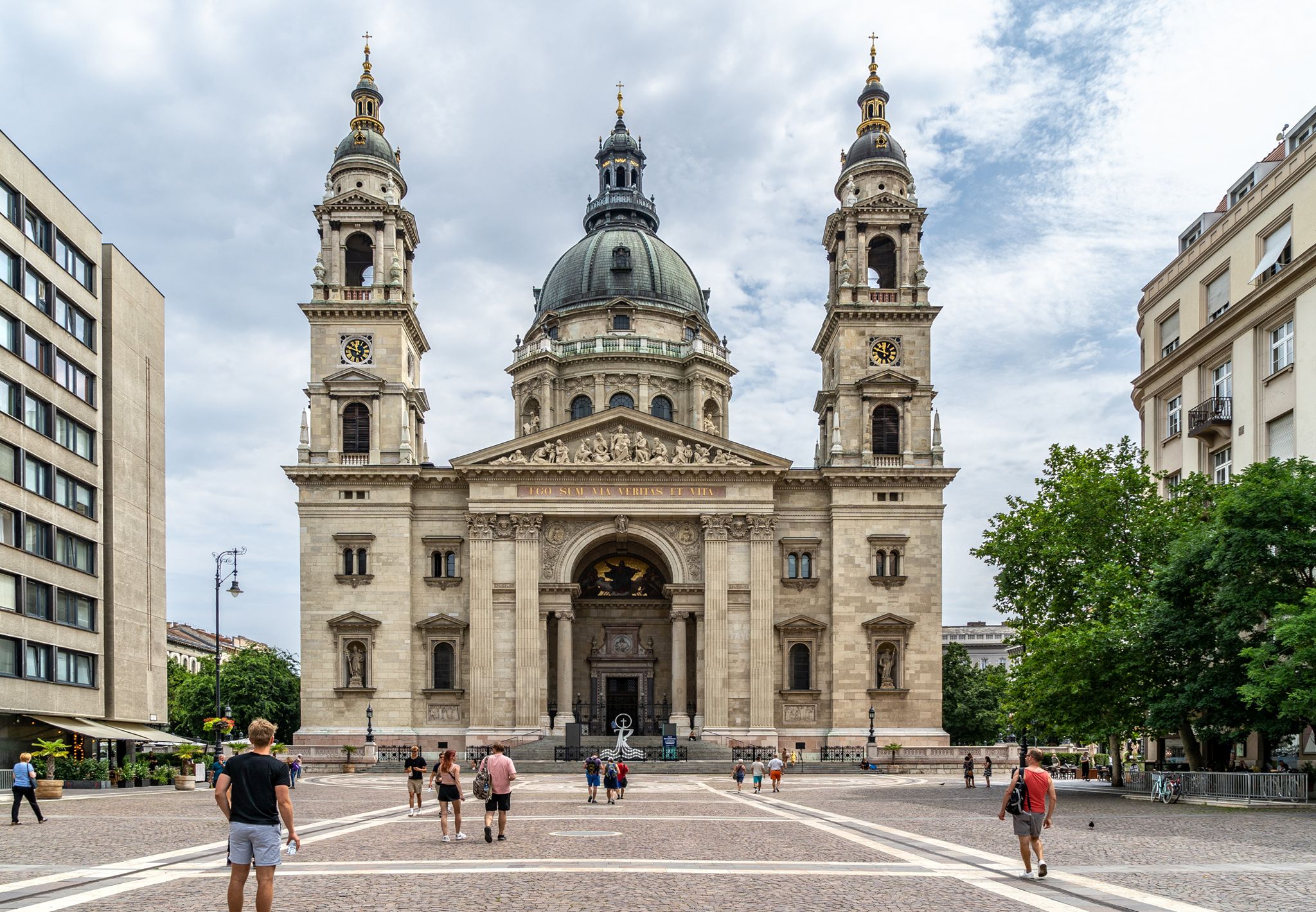
St. Stephen's Basilica (Photo: Balázs Both/pestbuda.hu)
The foundation stone was laid on 4 October 1851, and construction of the classicist building began. Nine years later, by 1860, the chapel behind the sanctuary was completed, which was used as a parish church until the consecration of the basilica. The construction of the church was greatly hindered by the fact that the dome of the building collapsed in 1868. Miklós Ybl (1814–1891) had to redo the plans of the Basilica.
József Kauser (1848–1919) took over the lead architect's role in 1891 after Miklós Ybl passed away. The consecration ceremony was held on 9 November 1905, at which the auxiliary bishop of Esztergom Medárd Kohl celebrated Mass.
The Assumption of the Blessed Virgin Mary bell was cast in 1863
The oldest bell in the church is the Assumption of the Blessed Virgin Mary bell, weighing 3,100 kg with a lower diameter of 178.5 centimetres, housed in the northwest tower of the basilica. It was cast by Ferenc Walser in 1863 in Pest. The bell was consecrated by Prince Primate János Scitovszky (1785–1866). The bell vehicle was donated by the owner of Ganz Abraham's iron foundry in Buda.
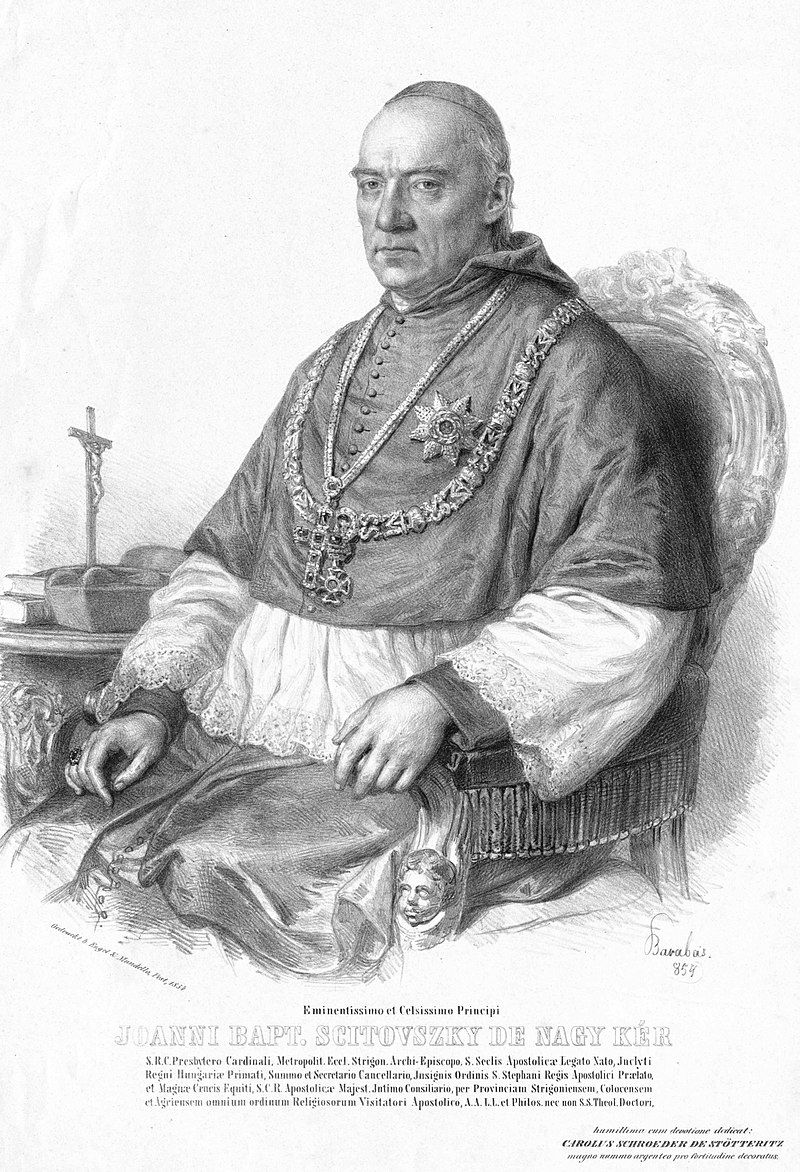
Portrait of Archbishop János Scitovszky, who blessed the bell made in 1863 by Miklós Barabás.
This is the only bell in the church that is the same age as the building. Its ornament shows the figure of the Virgin Mary standing on the globe. Its valuable inscription is in Latin. The following information about the Assumption of the Blessed Virgin Mary bell was published by the most popular periodical of the second half of the 19th century, Vasárnapi Újság: “The residents of Pest received a beautiful Christmas present this year. The new 5,600-pound bell of the basilica under construction in Lipótváros, which, after being consecrated on 10 December was lifted into the tower and first sounded at Christmas. It surpases the ordinary bells of pest in both beauty and voice.”
Four smaller bells cast in 1993 in Passau now hang to the right and left of the Bell. The bells are supported by a belfry made in 1866 by the iron foundry of Ignác Schlick. The mechanical clock of the church is in the same tower as the Assumption of the Blessed Virgin Mary bell. The clock's machinery is below the bell's level, but its dials were placed above it. The timepiece, made in 1866 by Johannes Mannhardt's (1798–1878) clockmaker factory in Munich, was donated to the parish by the church caretaker Antal Hampel.
The clock was one of the first in the country to be made with factory technology. Johannes Mannhardt, a watchmaker and mechanic, settled in Munich in 1827, where he set up a small workshop that later developed into a factory. He strived to create a framework for the industrial production of tower clocks.
He produced not only tower clocks but various machines in his factory. The Mannhardt workshop employed 40 people in 1844 and more than 230 in 1855. By 1861, more than 1,000 tower clocks had been produced in the factory. He made a clockwork with a free-swinging pendulum in 1862 and was given the sole right to manufacture such devices.
Originally, the clock only showed the time on the dials of the northwest tower of the basilica. The torque was transmitted to the southwest tower in 1890 by means of a transmission, which made it possible for a clockwork to provide the time on two towers at the same time.
The large bells in the southwest tower of the basilica
In 1892 the largest bell in the Austro–Hungarian Monarchy was placed in the south-western tower. The bell dedicated to the Holy Trinity and St. George was cast by Ferenc Walser (1827–1901). The bell weighing 7735 kilograms with a lower diameter of 220 centimetres was consecrated by György Schopper (1819–1895), the county bishop of Rozsnyó (now, Rožňava), on 19 April 1892.
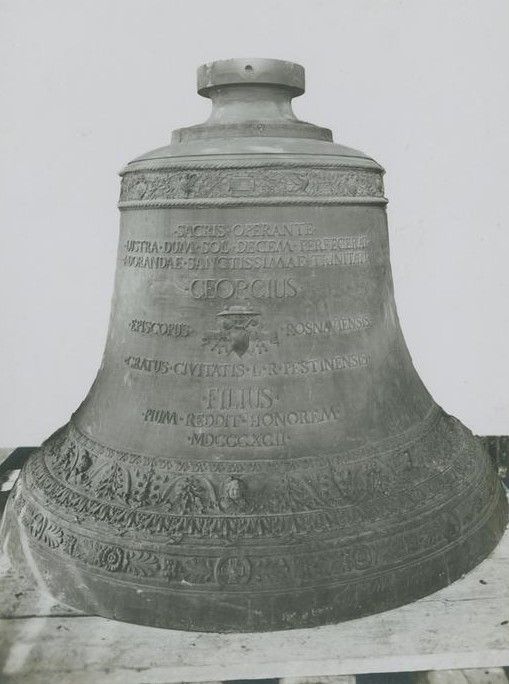
The large bell of the basilica from 1892, dedicated to St. George
During the First World War, this monumental bell was requisitioned for military purposes along with the other four bells of the basilica. For more than ten years thereafter, only the northwest tower of the basilica had a resounding bell.
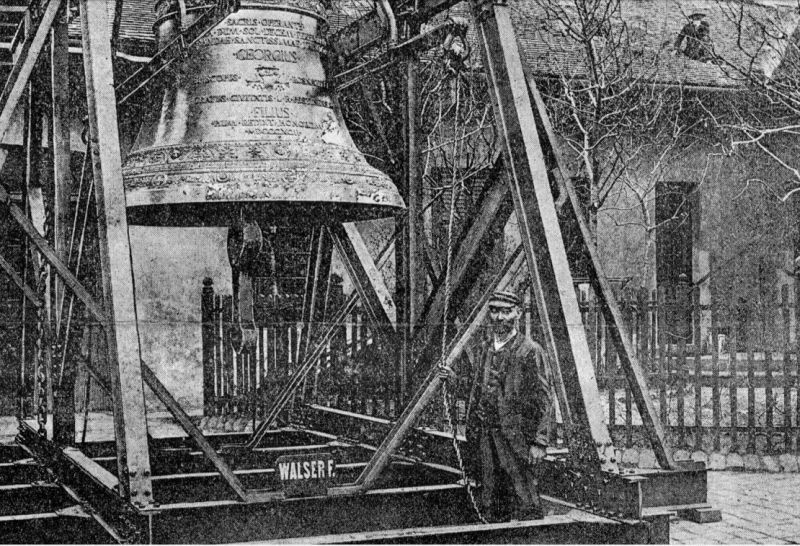
The Walser workshop with the large bell of the basilica in 1892
István Madarász (1884–1948), the abbot, began a movement to replace the bells of the basilica in 1927. The collection was strongly supported by Budapest, the Ministry of Religion and Public Education and the Ministry of Defense.
A bell was ordered by the parish in May 1929, which was made by László Szlezák (1870-1953), in his workshop in Angyalföld, Budapest. The cost of the bell was 42,140 pengos, an amount paid in several instalments by 24 March 1931. The design and decoration of the bell were planned by Tibor Gerevich (1882–1954), an art historian and university professor.
The large bell of the basilica, which weighs 7945 kg, received a double title: on the one hand, it was named the “Bell of Heroes”, and on the other, it was dedicated to Prince St. Emeric.
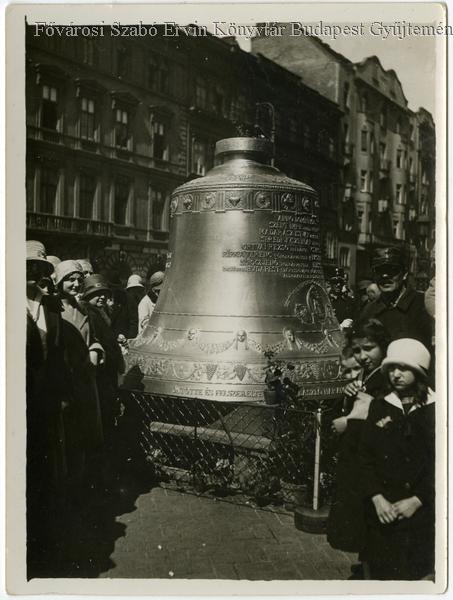
The great bell of St. Emeric in the basilica in 1930, made by László Szlezák (Photo: FSZEK Budapest Collection)
The consecration of the bell on 27 April 1930 was the first spectacular event of the Saint Emeric Memorial Year. The ecclesiastical ceremony was performed by Prince Primate Justinián Serédi (1884–1945) upon the bell placed in front of the steps of the basilica. The position of "bell mother" was taken by the Governor's wife, Magdolna Purgly.
Three weeks after the consecration of the bell, on 18 May 1930, a “great male pilgrimage” to Máriabesnyő began with 30,000 participants, and their return was greeted by the first sounding of the new bell.
Inscriptions and ornaments of the Heroes' / St. Emeric bell: On one side: "MAKE THIS BELL SOUND GOD'S GLORY AND CARRY OUR PRAYERS / FOR OUR HEROIC DEAD AND THE RESURRECTION OF HUNGARY" / AMEN."
Below the inscription, in the middle of an oval field framed by a cornucopia, the head of the deceased soldier is held by an angel.
ON THE OTHER SIDE OF THE BELL: "ANNO DOMINO MDCCCCXXX / SAINT EMERIC JUBILEE YEAR / FOLLOWING THE INITIATIVE OF MADARÁSZ IMRE / IN THE TIME OF / JUSZTINIÁN SERÉDI CARDINAL PRINCE PRIMATE / ORTVAI REZSO VICAR JAR JOZSEF PATRON COUNCILOR / KÁROLY RIPKA LORD MAYOR KÁROLY NAGY PARISH PRESIDENT / JENŐ SIPÖCZ MAYOR FLEISCHER TIHAMÉR CHURCH CARETAKER / THROUGH THE SACRIFICE OF THE CITIZENS AND THE FAITHFUL OF BUDAPEST"
Below the long inscription, above the relief, the following text: “PRINCE SAINT EMERIC! PRAY FOR US!” In a ring around the base: "CASTED AND FITTED BY LÁSZLÓ SZLEZÁK GOLDEN WREATHED BELL FOUNDER IN BUDAPEST 1930."
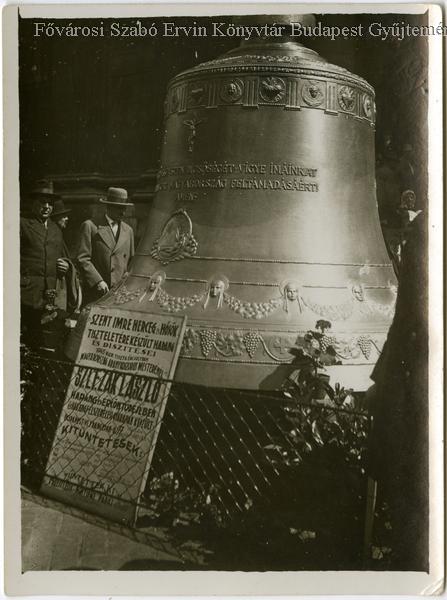
The large bell of St. Emeric in the basilica on 8 May 1930. On the ground, in front of it, a board reports about the bell founder, László Szlezák and its making. "Made in honour of Prince St. Emeric and Heroes ..." (Photo: FSZEK Budapest Collection)
Decorations on the waist of the bell: At the bottom vines run with a cross, above it a row of fruit garlands, between which women faces can be seen, towards the top of the bell a wounded heart and a winged angel. The figure of St. Emeric kneeling in a frame, with a coat of arms on either side, the coat of arms of Hungary and Budapest.
The bell was the pride of the Szlezák family, expressing this, a special memorial card was issued by the foundry to commemorate the consecration of the bell. The card displayed a bust of St. Emeric wearing an open crown adorned with precious stones, his long hair reaching to his shoulders and a short black moustache above his lips. In the portrait, an attribute of its purity, the white lily, appears. László Szlezák also noted in every advertisement that "the new 7945 kg bell of the Budapest Basilica was made in my factory".
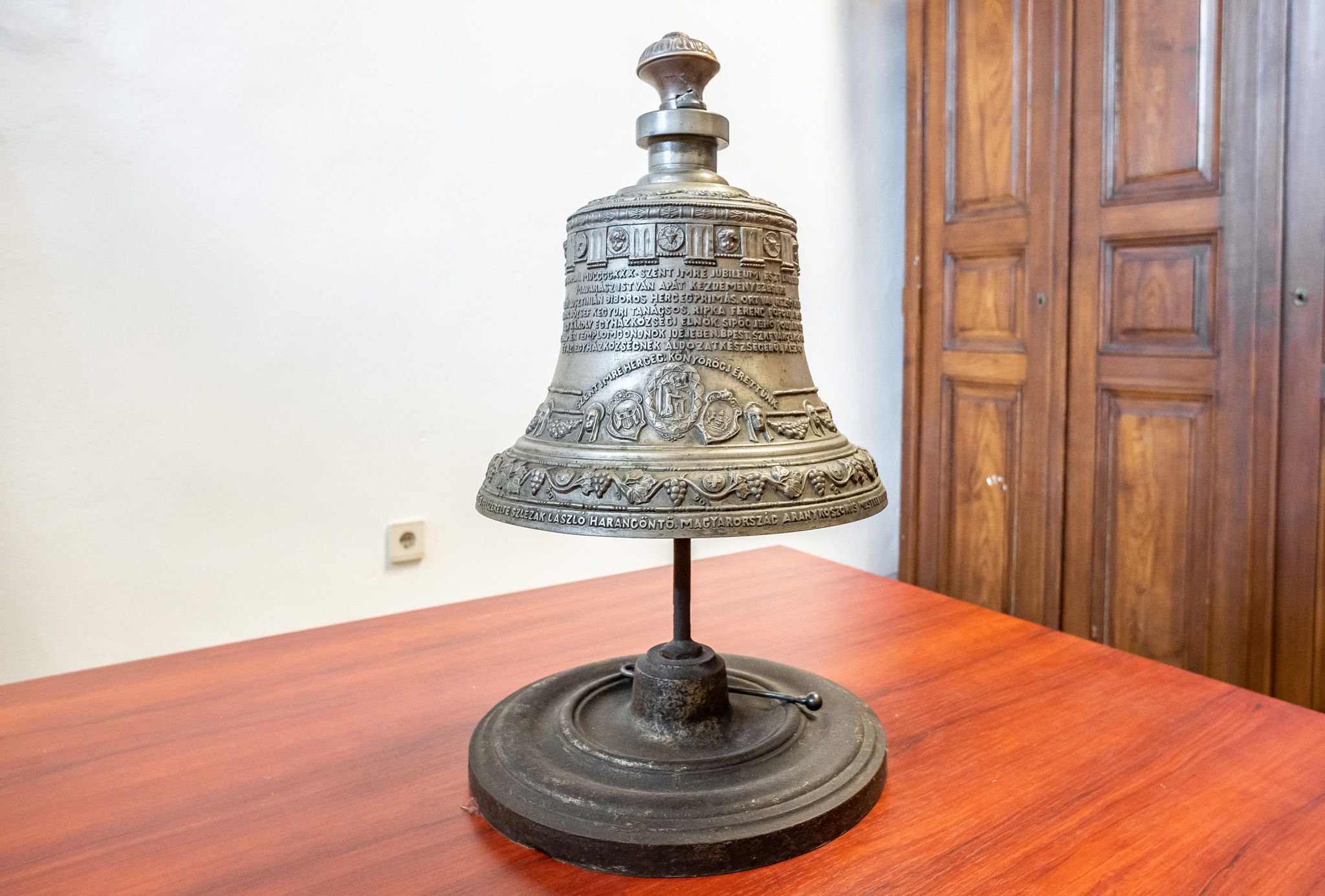
Model of the Saint Emeric bell (Photo: Balázs Both/pestbuda.hu)
The Heroes / St. Emeric bell was taken for military purposes on 20 May 1944 by the German army. In this way, not only Hungarian Catholicism suffered irreparable loss, but also research into the history of Hungarian bells. A scaled-down replica of the bell was donated to the basilica in 1930 by László Szlezák, which was on display next to the altar in the Holy Right Chapel. Today, the small bell is locked and kept among the treasures of the parish.
The bell of St. Stephen cast in 1990
The largest bell in Hungary is 9250 kg, with a lower diameter of 240 cm, made in 1990 at the Perner foundry in Passau. The bell was transported to the Hungarian capital from the Bavarian city along the Danube by a riverboat named after Mozart. The imposing bell was dedicated by Archbishop László Paskai (1927–2015) on 20 August 1990. -
There is a relief of St. Stephen with the Hungarian Holy Crown on the ruler's head. The representation is unique in that the cross stands vertically on the crown.
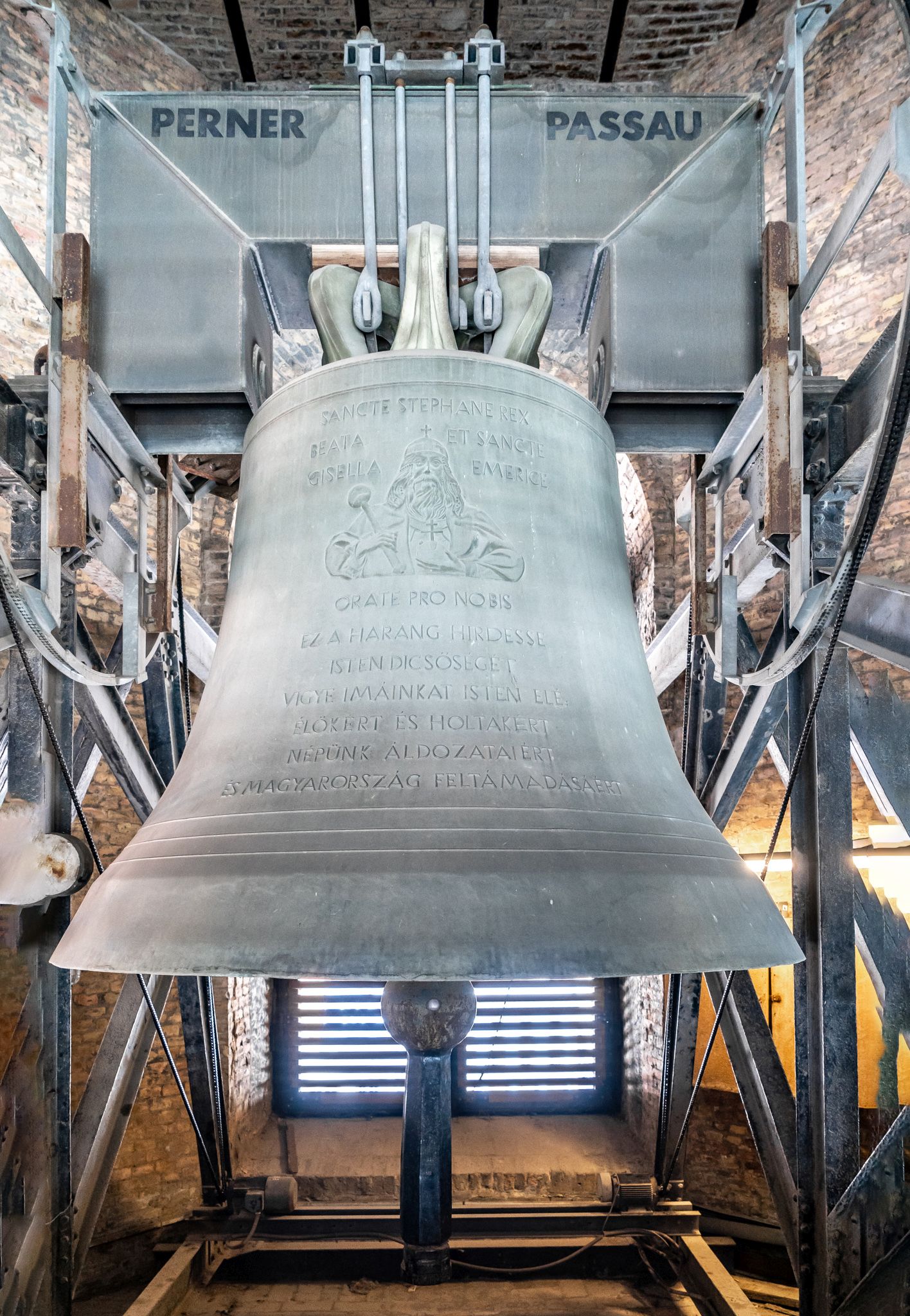
St. Stephen's Bell (Photo: Balázs Both/pestbuda.hu)
Inscription surrounding the St. Stephen relief:
"SANCTE STEPHANE REX BEATA GISELLA ET SANCTE EMERICE ORATE PRO NOBIS" (in English: King St. Stephen, Blessed Gizella and St. Emeric pray for us."
Then below in Hungarian: "LET THIS BELL PROCLAIM THE GLORY OF GOD, BRING OUR PRAYERS FOR THE LIVING AND THE DEAD, FOR THE SACRIFICES OF OUR PEOPLE AND FOR THE RESURRECTION OF HUNGARY TO GOD."
The inscription related to the making of the bell can be read on the mantle of the casting: “IN MEMORY OF KING SAINT STEPHEN AS A DONATION OF THE EDITORS AND READERS OF BILD POST IN PREPARATION FOR THE VISIT OF POPE JOHN PAUL II, DURING THE RENOVATION OF THE BASILICA UNDER CARDINAL LÁSZLÓ PASKAI. THE PREVIOUS BELL WAS CAST IN 1930 IN MEMORY OF KING SAINT STEPHEN'S AND HIS WIFE BLESSED GIZELLE'S SON, SAINT EMERIC IN THE WORKSHOP OF LÁSZLÓ SZLEZÁK IN 1930. IT WAS TAKEN FOR MILITARY USE ON 20 MAY 1944."
The basilica had four new bells made in 1993
In 1993, the Bavarian Perner company cast four more bells for St. Stephen's Basilica, which were placed in the northwest tower of the church. Each of the bells bears the logo of the foundry, a large letter P with the inscription Perner / Passau on the stem.
In addition to Hungarian, the bells also have a German inscription. The castings were dedicated to St. Henry, Blessed Gizella, St. Emeric, and St. Elizabeth.
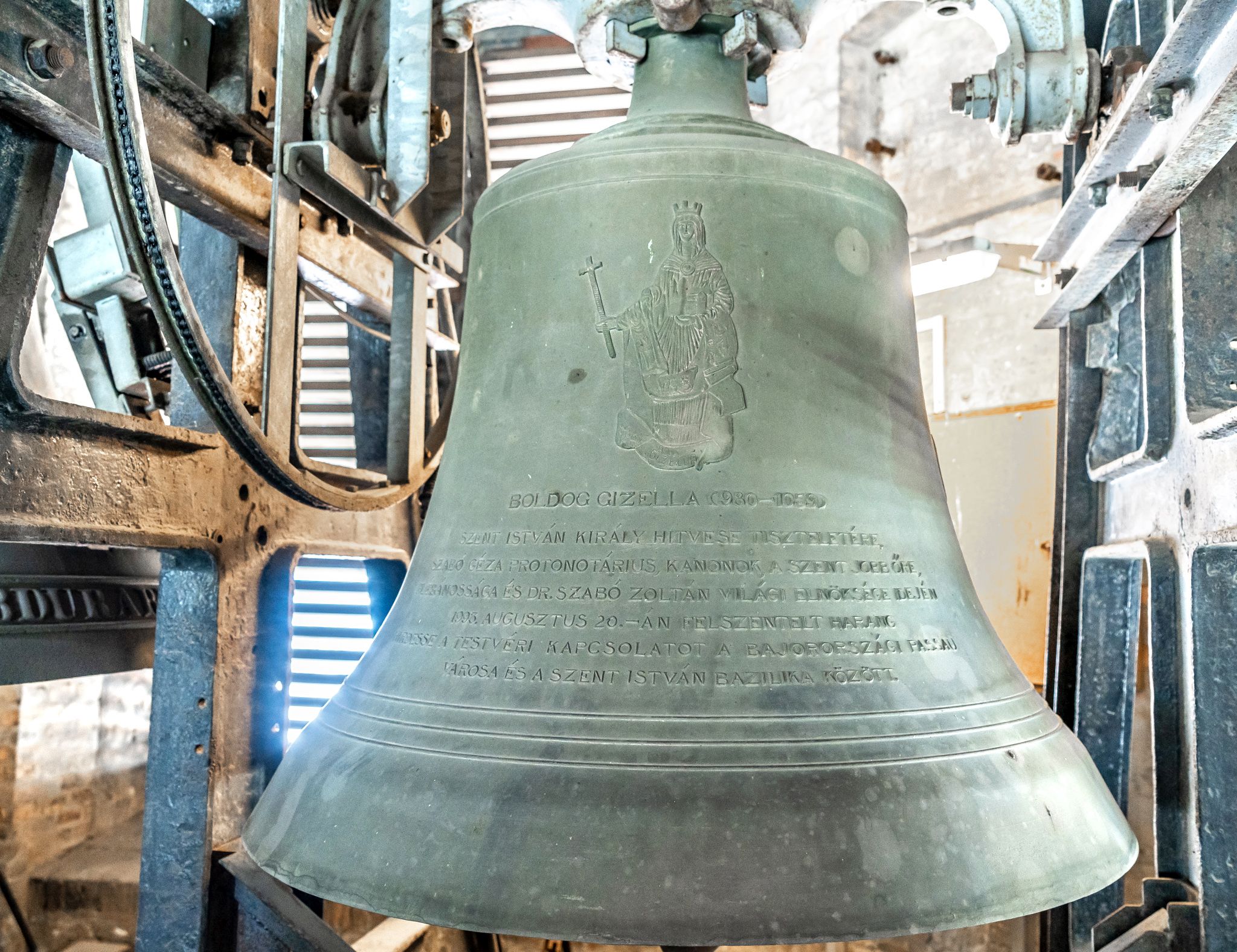
Bell dedicated to Blessed Gizella (Photo: Balázs Both/pestbuda.hu)
At the dawn of the 21st century, more and more Hungarian churches replaced the bells that were taken during the Second World War. These are often decorated with the Hungarian coat of arms of the Holy Crown of Hungary to symbolise that a nation rich in spiritual treasures can replace any material loss.
Cover photo: Bells of St. Stephen's Basilica (Photo: Balázs Both/pestbuda.hu)

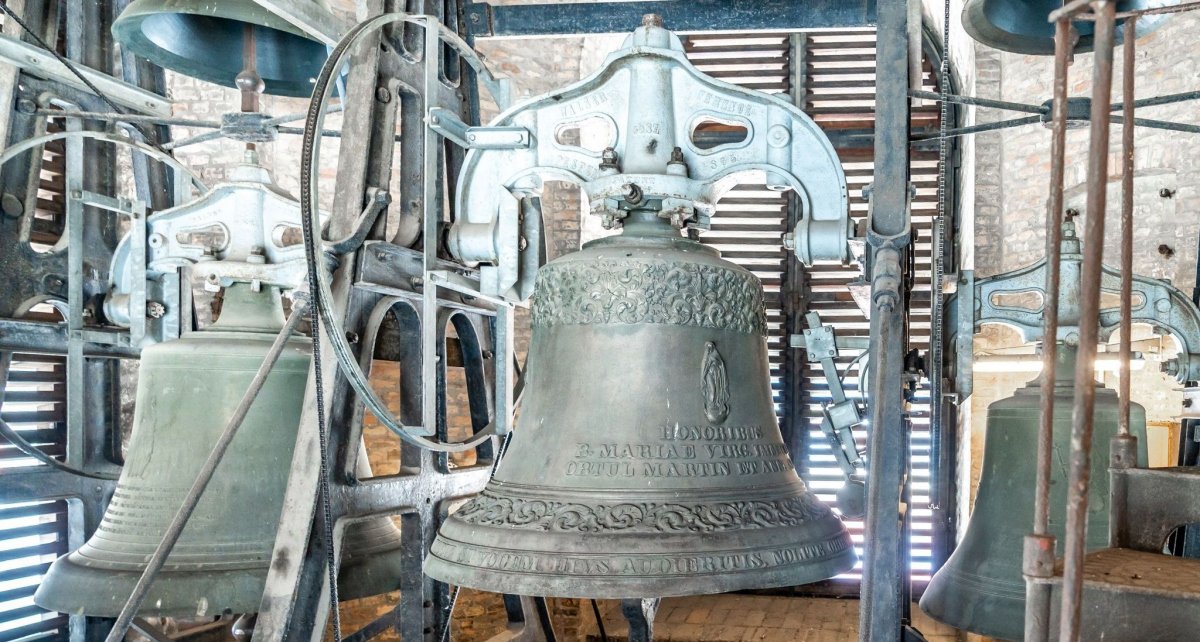

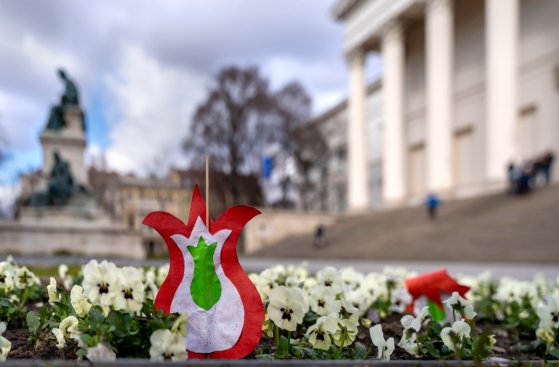

































Hozzászólások
Log in or register to comment!
Login Registration